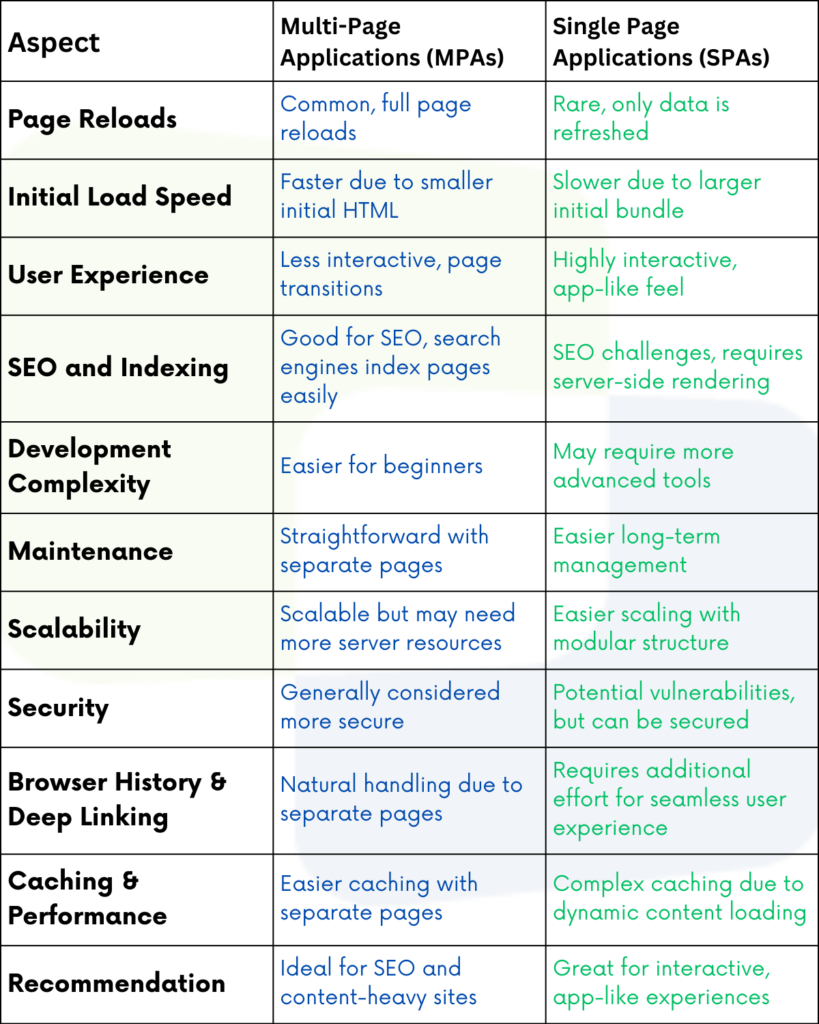Single-Page Applications vs Multi-Page Applications: Key Differences You Need to Know

Selecting the appropriate project architecture is vital in web development. You frequently come across Single Page Applications (SPAs) and Multi-Page Applications (MPAs) as prominent choices. Both options have their pros and cons. This blog post will elucidate the distinctions between them, aiding you in making a well-informed project choice.
Introduction to SPAs and MPAs
Before we delve into the comparison, let’s get a grasp of what SPAs and MPAs entail.
Single Page Applications (SPAs): SPAs are web apps that load one HTML page initially and then smoothly update that same page as the user interacts with it. This creates a more seamless, app-like user experience.
Multi-Page Applications (MPAs): Conversely, MPAs are made up of several HTML pages, each representing a different view or section of your app. When a user clicks a link, the entire page is typically refreshed from the server.
User Experience (UX)
SPAs provide a smooth user experience. After loading the first page, the server fetches only the necessary data, resulting in quick subsequent interactions. This makes the app feel fast and enjoyable for users.
MPAs can feel a bit slower because they often need to reload the entire page. However, modern techniques like AJAX can help reduce this delay somewhat. Still, the user experience might not be as smooth as with SPAs.
Performance
When it comes to how fast they load initially, SPAs might be a bit slower because they require downloading a larger bundle of JavaScript for the app to work. However, once loaded, SPAs generally move between different parts of the app more quickly.
In terms of how fast they load the first page, MPAs excel because they only load what’s needed. But, as we mentioned earlier, moving between pages can be slower because they have to reload the entire page.
SEO and Accessibility
SPAs may have some challenges with SEO because search engines might not index content created with JavaScript effectively. MPAs, which use traditional server-rendered pages, tend to do better in terms of SEO. However, modern SPAs can solve this problem by using server-side rendering (SSR).
Development and Maintenance
SPAs often need more advanced development tools and libraries, which can make them a bit trickier to set up and maintain initially. However, once up and running, managing them can be simpler because they break down into modules.
MPAs, being the traditional approach, have a lower barrier to entry. They’re easier for new web developers to grasp, and maintaining them is straightforward because each page is like a separate piece.
Scalability
SPAs work well for projects that expect to grow quickly. Their modular structure makes it easier to expand, and they can handle a lot of users and traffic efficiently. MPAs can also scale, but they might need more server resources, especially when you have many pages and users.
Security
SPAs can sometimes have security issues like Cross-Site Scripting (XSS) because they rely heavily on client-side JavaScript. However, following best practices can help reduce these risks.
People generally see MPAs as more secure because they rely less on client-side JavaScript and benefit from established security practices.
Browser History and Deep Linking
SPAs often manage browser history and deep linking with client-side routing, which can be smoother for users but might need extra work to ensure it always works right. MPAs, on the other hand, naturally handle browser history and deep linking because each page has its own URL. This makes it easier to share links and provides better support for browser navigation.
Caching and Performance Optimization
When it comes to caching, SPAs can be a bit trickier because they load content dynamically. But if you set it up correctly, you can still get great caching results.
MPAs have a simpler way of handling caching since each page is separate. It’s easier to set up and keep track of caching for them.

Conclusion
To sum it up, deciding between SPAs and MPAs hinges on your project’s specific needs:
If you aim for a highly interactive user interface, swift page transitions, and an app-like feel, SPAs are great for complex applications like online editors, dashboards, and social networks.
If your project revolves around content delivery, SEO, and straightforward development, MPAs work well for blogs, news sites, and smaller projects where SEO matters.
Consider your project’s objectives, user expectations, and development resources when making your choice.
We can assist you in making the right choice between Single Page Applications (SPAs) and Multi-Page Applications (MPAs). We understand that your project’s success depends on selecting the appropriate architecture. Our experienced team can analyze your project’s goals, user expectations, and development resources. Whether you need a highly interactive SPA or an SEO-focused MPA, we provide customized solutions to optimize the user experience and performance. With our expertise and adaptability, Appfoster ensures your web development project’s success, delivering the best outcomes for your specific needs.

